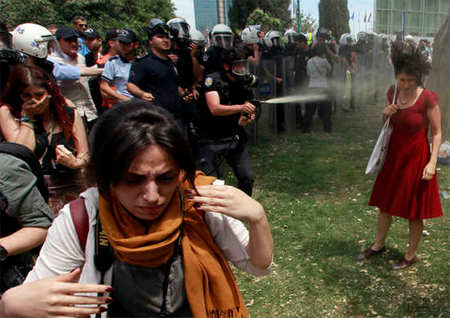Prime Minister Recep Tayyip Erdoğan’s government should end police violence and excessive use of force against protests across Turkey. Officials should uphold the right to peaceful protest and free speech.
Police violently dispersed peaceful protests against government plans to transform Istanbul’s Taksim Gezi park into a shopping mall, triggering wider public protests across Istanbul that spread to Ankara and other cities.
[...] The protests are continuing amid signs that what began as an environmental movement against an urban regeneration project has become a wider expression of discontent with government policies by people across the political spectrum. There has been little live coverage of the events on Turkish television channels, though there has been coverage, including many photographs, on news websites and social media.
The Istanbul governor’s office reported on May 31 that only 12 people had sustained serious injuries and 63 had been detained by police. But information from eyewitnesses about the force used by police and the number of protesters involved suggests that the number of injured is likely to be very much higher.
Human Rights Watch interviewed political commentator and academic Ahmet Insel, who reported seeing ambulances repeatedly ferrying people to the Taksim İlk Yardım Hospital on May 31, 2013. Ahmet Insel told Human Rights Watch that he visited the Alman Hastanesi (German Hospital), where a 23-year-old student from Istanbul Technical University had been admitted, said by doctors to have lost his eye after being shot at close range by the police. A doctor told Insel that hospital staff had removed a plastic bullet from the student’s eye.
Journalist Ahmet Şık told Human Rights Watch that when he tried to visit Taksim Gezi Park with a delegation from the opposition Peoples’ Republican Party (CHP), including members of parliament, police threw a gas capsule at his head at close range. He sustained trauma to his head, which was bleeding profusely, and was taken immediately to a hospital.
“The Turkish authorities should urgently review policing policies and hold to account police chiefs whose units attacked peaceful protesters,” Sinclair-Webb said. “The government should also examine police use of tear gas, which poses a significant health risk and can be lethal.”
Erdoğan stated on June 1 that the government would go ahead with plans to transform Taksim Gezi park. He condemned the protests as a “game” and although he admitted mistakes in the use of tear gas by the police, he indicated there would be no retreat, asserting, “the police were there yesterday, and police will be there today and tomorrow.” By the afternoon of June 1, after repeated use of tear gas to disperse thousands of demonstrators massing in the main streets leading to Taksim square and Gezi park, the police began to withdraw from Taksim square and thousands of people moved into the square and park.
Human Rights Watch has noted Turkey’s restrictions on free speech and politicians’ intolerance of dissenting voices, and criticized Turkish police’s routine ill-treatment of demonstrators, and the failure to hold to account officers who use excessive force.
Protests against the demolition of part of Taksim Gezi Park to widen a street began at night on May 27, when a campaigner staged a non-violent sit-in to stop the works. The demolition is connected to a major tunnel-construction project that will route traffic to run under the square. Protesters believed the demolition was the first step in a government project to transform the tree-lined park, one of the city’s few green spaces, into a shopping mall. The project is controversial, because the prime minister imposed the scheme without public consultation, despite significant opposition.
On the afternoon of May 28, after the demolition had restarted under police protection, Istanbul Peace and Democracy Party (BDP) member of parliament Sırrı Süreyya Önder stood before the bulldozers to stop it. He protested that this leg of the project had not been authorized and was unlawful. Önder’s action temporarily brought the demolition works to a halt again. Campaigners then staged a peaceful sit-in in the park, refusing to leave.
At around 5 a.m. on May 30, police raided the park and forcibly removed the campaigners, using tear gas. At least one man was injured. Quickly regrouping, campaigners continued their sit-in and the police conducted two raids on May 31. CHP member of parliament İlhan Cihaner was among those who suffered excessive exposure to tear gas that day.
Major conduits leading to Taksim were brought to a standstill on May 31, as police repeatedly repelled advancing groups of demonstrators. In the early evening, a Human Rights Watch researcher witnessed the events on Cumhuriyet Caddesi, a major avenue running alongside the park, from the upper floors of an office building. Few demonstrators on Cumhuriyet Caddesi used force, though a handful threw stones at the water cannon vehicles as they advanced. Police moved on the demonstrators, firing repeated rounds of tear gas canisters, sometimes at very close range. Small groups of protesters retreated down side streets and sheltered in buildings. This continued for hours, with demonstrators sometimes assembling to cheer, sing, shout slogans, beat drums, and beat on the iron barricades they had dismantled from the construction site.
CHP member of parliament Sezgin Tanrikulu was hospitalized after suffering a mild heart attack caused by exposure to tear gas on May 31. Önder was hit in the shoulder and foot by a tear gas capsule fired by the police.
On May 31, Istanbul governor Avni Mutlu blamed the protesters for spreading disinformation, and blamed provocateurs who had no interest in protecting the environment.
By contrast, the mayor of greater Istanbul, Kadir Topbaş, expressed remorse, saying officials had failed to tell campaigners that the demolition was for road works and not linked to the shopping mall project.


Nessun commento:
Posta un commento
Nota. Solo i membri di questo blog possono postare un commento.